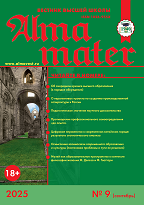UDC 130.2
https://doi.org/10.20339/AM.04-23.098
Nadezhda V. Mihailova, Cand. Sci. (History), Associate Professor of the chair “History, Archeology and Local History” at Vladimir State University named after Alexander and Nikolay Stoletovs, e-mail: cnadezhda@yahoo.com
The purpose of the article is a cultural–semiotic analysis of discrimination as a type of relationships and interactions between Ours and Others. The hypothesis of the study is that the transition to a post-cultural model of the functioning of the semiosphere will contribute to the weakening of the discriminatory potential of semiotic systems. To achieve this goal, the symbolic nature of the images of Ours and Others is considered, which are analysed in the context of their correlation with referents; discrimination as a set of worldview attitudes is associated with sign-generating and metalanguage activities in the field of regulating relations between Ours and Others as signs; outlines the contours of a culture-semiosphere with a reduced discriminatory charge. The novelty of the research lies in the application of a cultural-semiotic approach to the study of the phenomenon of discrimination. The author comes to the conclusion about the ambivalence of chaos as a referent in the context of the semiosis of discrimination: chaos can act both as a referent of discrimination signs and as a referent of anti-discrimination signs through the actualization of its threatening or creative potential. In this regard, a view is being formed on post-culture with its activation of personal life creation and individual semiospheres as a time and space favorable for weakening discriminatory attitudes, ideas and practices while maintaining alienation as a whole as a universal mechanism of cultural self-regulation.
Keywords: discrimination, discriminatory attitudes, Ours, Alien, sign, text, referent, semiosphere, semiosis, post-culture.
References
- Brubaker, R. Ethnicity without groups. Moscow: Publ. House of HSE, 2012. 408 p.
- Gadzhiev, K.S., Gusov, K.N. Discrimination. The Big Russian Encyclopedia [website]. URL: https://bigenc.ru/law/text/1958348 (accessed on: 14.11.2022).
- Markov, V.I. Alienation in culture: Author’s thesis of Dr. dis. (Culturology). Kemerovo, 2002. 35 p.
- Markov, V.I. Tolerance in cultural space. World of Science, Culture and Education. 2013. No. 5 (42). P. 383–385.
- Pelipenko, A.A. Comprehension of culture. In 2 parts. Pt. 1. Culture and sense. Moscow, 2012. 607 p.
- Pelipenko, A.A. Freedom in culture. Culture of culture. 2014. No. 1. URL: http://cult-cult.ru/a-a-pelipenko-svoboda-v-kuliture/ (accessed on: 14.11.2022).
- Rozin, V.M. ‘Postculture’ conception. Culture and art. 2019. No. 6. P. 45–52.
- Rozin, V.M. Postculture as basis for concepts of culture diversification. Culture of culture. 2020. No. 2. URL: http://cult-cult.ru/v-m-rozin-postculture-as-the-basis-for-the-distincti... (accessed on: 14.11.2022).
- Sadohin, A.P. ‘Our – Alien’ in intercultural communication : approaches to the problem research. Culturology issues. 2007. No. 3. P. 15–19.
- Flier, A.J. Theory of culture as philosophy of history. Culture of culture. 2014. No. 1. URL: http://cult-cult.ru/teoriya-kulitury-kak-filosofiya-istorii/ (accessed on: 14.11.2022).
- Shamionov, R.M. Forming of personal discriminatory attitudes in one’s socialization process. Saratov University news. New series. Series “Educational acmeology”. Developmental psychology”. 2018. Vol. 7. Iss. 2 (26). P. 129–135.
- Shapinskaya, E.N. Creativity in postcultural context: limits of interpretation. Yaroslavl pedagogical vestnik. 2014. Vol. 1. No. 2. P. 223–228.











.png)






